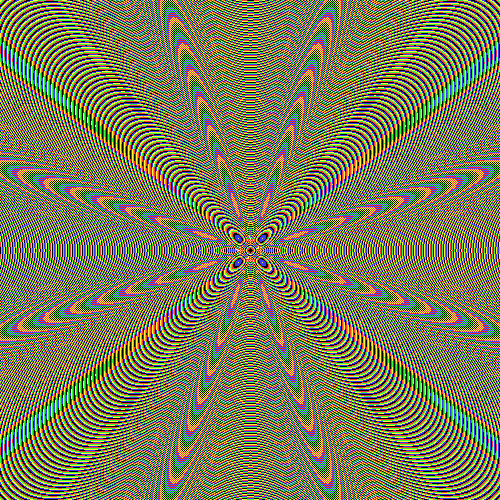When you divide one integer by another, one of two things happens. Either the second number goes perfectly into the first or there’s a remainder:
15 / 5 = 3
18 / 5 = 3⅗
In the first case, there’s no remainder, that is, the remainder is 0. In the second case, there’s a remainder of 3. And all that gives you the basis for what’s called modular arithmetic. It returns the remainder when one number is divided by another:
15 mod 5 = 0
16 mod 5 = 1
17 mod 5 = 2
18 mod 5 = 3
19 mod 5 = 4
20 mod 5 = 0
21 mod 5 = 1
22 mod 5 = 2...
It looks simple but a lot of mathematics is built on it. I don’t know much of that maths, but I know one thing I like: the patterns you can get from modular arithmetic. Suppose you draw a square, then find a point and measure the distances from that point to all the vertices of the square. Then add the distances up, turn the result into an integer if necessary, and test whether the result is divisible by 2 or not. If it is divisible, colour the point in. If it isn’t, leave the point blank.
Then move on to another point and perform the same test. This is modular arithematic, because for each point you’re asking whether d mod 2 = 0. The result looks like this:
d mod 2 = 0
Here are more divisors:
d mod 3 = 0
d mod 4 = 0
d mod 5 = 0
d mod 6 = 0
d mod 7 = 0
d mod 8 = 0
d mod 9 = 0
d mod 10 = 0
d mod various = 0 (animated)
You can also use modular arithmetic to determine the colour of the points. For example, if d mod n = 0, the point is black; if d mod n = 1, the point is red; if d mod n = 2, the point is green; and so on.
d mod 3 = 0, 1, 2 (coloured)
d mod 4 = 0, 1, 2, 3 (coloured)
d mod 5 = 0, 1, 2, 3, 4 (coloured)

d mod 5 = 0, 1, 2, 3, 4 (animated and expanding)













